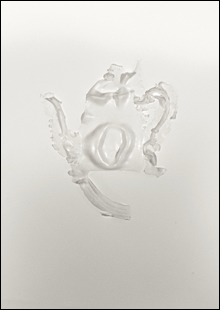
PAINTERLY TOUCH “Whiteware — Teapot,” by Jeffrey Clancy, silicone rubber and paper, 22 x 30 inches, 2010. |
Jeffrey Clancy plays with craft theory through the lens of a metalsmith working with traditional techniques and decorative motifs. In "Vestige," now on view at Gallery 37-A, seven of his pristine white sculptural works on paper are hung like relics surrounding a black table, where a stainless steel platter and two serving utensils are laid out as exhibits in some decadent Kubrick-esque trial. The work is both delicate and dramatic, initially hiding a pervasive messiness.Clancy, who is an assistant professor in metalsmithing and jewelry at the Maine College of Art and has exhibited both nationally and internationally, filters questions of permanence and impermanence as related to social and economic assumptions through decorative and utilitarian objects. The works featured here also address collectability and status, as they are unique and fall into a most definite category of art versus craft, as opposed to the utilitarian objects they reference, which are often mass-produced.
In "Whitewares," Clancy's latest body of work, limp molds of hollowware are affixed to paper, with white silicone rubber bubbling and creasing over white paper to play with light and shadow. Recognizable forms of elaborate and elegant handles, spouts, and lids emerge from the glossy and tactile silicone, but are degraded by irregular distortion where the molds are stretched, ripped, or cut. Upon closer inspection, grit, hair, and other accretions are stuck to the rubber, a negligence by the artist that adds an unsanitary grossness to what initially appears immaculate, and emphasizes the inherent semen-like quality of the material.
The forms are unapologetic in their dishevelment, finding a distinguished levity bordering on whimsy. This may be a symptom of the works' haphazard compositions, or the inclination for decorative motifs to border on the zoomorphic. Tattered edges of ripped and stretched silicone both resemble an overstuffed trash bag and mimic the defined ribbing or floral decorative elements on hollowware and dishware. They are concurrently collapsed death masks and the dregs of the fabrication process; they evoke preserved but nonfunctional societal elements and perhaps the appropriation of those into something new.
The profile of a Victorian-inspired teapot is centered in "Whiteware — Teapot," its bulbous center caved and fine details crumpled. The base of the form has been severed from the rest of the body, and drags below. The application of rubber to paper is painterly, and the physicality of the silicone highlighted by the subtlety of definition in white on white.
The metalwork featured in "Vestige" is lost-wax cast, and melds exposed thumb prints and natural imagery with decoration derived from naturalism. The pieces are rough around the edges, undesirable and unwieldy as utilitarian objects, but seemingly indestructible permanent cultural artifacts. The serving utensils are comprised of cast oyster and clamshell spoons with bone and lobster-claw handles, all washed out in monochromatic steel, the lobster harkening to surrealists Dali and Hugo Ball. The objects look more like weapons than aristocratic tools. The contrast of "Whiteware" with Clancy's metalwork allows the former to ephemerally cite and re-contextualize the latter, lending the stainless steel greater physical and conceptual weight.
Annie Larmon can be reached at aglarmon@gmail.com.
"VESTIGE" | works by Jeffrey Clancy | through September 26 | at Gallery 37-A, 37A Wharf St, Portland | thirtysevena.com